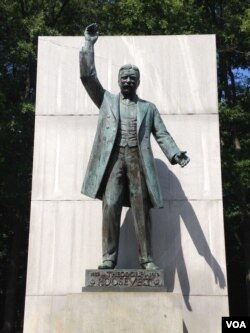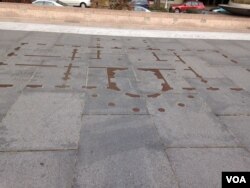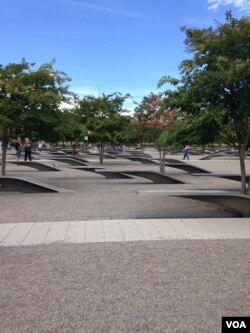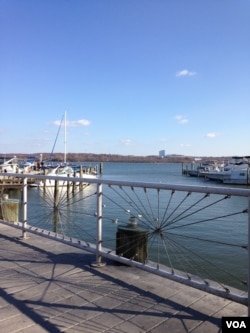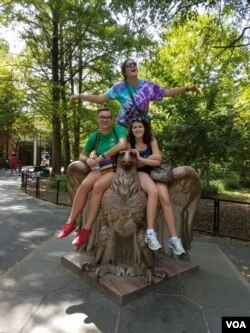Student Union
Have Metro, Will Travel: A Student's Guide to D.C.
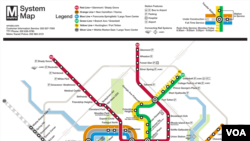
Why not D.C.?
Washington, D.C. was built on a strategically chosen plot of land on the Potomac River. Contrary to popular belief, it was not built on a swamp. It was designed by French-born, American designer and engineer Pierre Charles L’Enfant, whom Washington.org says, "Presented a vision for a bold, modern city featuring grand boulevards" reminiscent of Paris.
Founded in 1790, the District was a compromise between Alexander Hamilton and Thomas Jefferson, who wanted the Capital in different places. (Jefferson wanted "the capital placed in a location friendly to slave-holding agricultural interests," according to Washington.org.)
L'Enfant's vision lives on successfully, and D.C. today is not only home to American government, but also to incredible architecture, beautiful green spaces, monuments and more.
If you are planning a trip to D.C. to experience American history and culture, (and, of course, take that incredible tourist photo of touching the tip of the Washington Monument), there are a ton of ways to enjoy it that are fairly inexpensive. Free parks and monuments dot the landscape of the city.
Here are six places in D.C. easily accessible by public transit.
Theodore Roosevelt Island
Theodore or "Teddy" Roosevelt Island is an island in the middle of the Potomac honoring the 26th President of the United States. According to the National Parks Service it's about 88.5 acres of woodlands. You can walk around the entire island to see wildlife and beautiful views of the Potomac. In the middle, there is a statue of Roosevelt himself. If you are tired of the city itself, this island is a perfect getaway into nature that isn't totally out of the way. The views of Georgetown are lovely.
Cost: Free
Closest Metro Station: Rosslyn on the Blue, Orange or Silver lines.
Franklin Delano Roosevelt Memorial
Yes, another Roosevelt. The Roosevelts have some of the most gorgeous memorials in D.C. This one is dedicated to the 32nd President of the United States, and each of the four terms of his presidency has its own room. With walls covered with some of Roosevelt's most inspirational quotes -- "The only thing we have to fear is fear itself" -- and statues of Americans listening to Roosevelt's radio addresses or standing in bread lines, the memorial is a trip through time. If you're in D.C. for longer than a few days, it's also a great place to study. Sit by Roosevelt's statue and watch as people touch his finger for good luck. (And maybe slyly do the same on your way out. Hey, we could all use some luck!)
Cost: Free
Closest Metro Station: Smithsonian on the Blue, Orange or Silver lines.
Freedom Plaza
While I was exploring D.C., I decided to walk through Pershing Park, and came upon this plaza by happenstance. On the ground there are quotes from American luminaries about D.C., along with a giant stone map of the Capital. You may not be able to step inside of the real White House, but you can step on top of it here!
Cost: Free
Closest Metro Station: Metro Center on the Red, Blue, Silver or Orange lines, or Federal Triangle on the Blue, Orange or Silver lines.
The National 9/11 Pentagon Memorial
If you are looking to honor those who lost their lives on 9/11 at the Pentagon, the National 9/11 Pentagon Memorial in Arlington, Virginia is a good place to start. The memorial is organized by the age of the victim, each victim receiving their own bench to commemorate their life. I went on 9/11 this year, and the memorial was filled with people paying their respects, and looking at the pictures left by the families of the loved ones they lost all those years ago.
Cost: Free
Closest Metro Station: Pentagon on the Blue or Yellow line.
King Street/Old Town Alexandria/Alexandria Waterfront
King Street in Alexandria is filled with shopping, food and historic sites. One could take their time, spend the entire day, and probably not even get a few blocks down. At the end of King Street is the waterfront, where you can relax on a bench and watch the boats go by. And, if you are tired from all of the walking you've done by the time you get there, you can take the free King Street Trolley back to the Metro station. (It goes both ways, so if you'd rather use the trolley both ways, it's very handy!)
Cost: Free, unless you splurge on food and gifts.
Closest Metro Station: King St.-Old Town on the Yellow or Blue lines.
Smithsonian National Zoological Park
The Smithsonian National Zoological Park is part of the Smithsonian family in D.C., meaning it's all free. There are all sorts of fascinating animals at the zoo beyond the normal lions, tigers, and bears. (Oh my!) Asian elephants, pandas, sloths and vipers are all on display. The zoo is a great way to spend a day, and there are many seasonal events to enjoy there, like Zoo Lights in December.
Cost: Free. Pack a lunch to avoid food costs.
Closest Metro Station: Woodley Park (Zoo/Adams Morgan and walk north on Connecticut Avenue) or Cleveland Park (walk south on Connecticut Avenue) on the Red line.
How to get to D.C.
Before you get around the city, you have to get to the city!
- Fly: There are three airports. Washington National Airport is the closest to downtown D.C., and is directly on a Metro line. Baltimore/Washington International Airport and Washington Dulles International Airport require more travel into the city, but fares are often less expensive than the conveniently located National Airport.
- Amtrak: Amtrak trains come to Union Station, which is Metro accessible, and just blocks from the Capitol.
- Bus: A good selection of buses end at Union Station, including Greyhound and MegaBus.
Some ways to stay in D.C.
- Airbnb
- Hotels, like the Holiday Inn Washington-Capitol, which is a few blocks from the Mall. I stayed here before moving in for the fall semester, and it was really great to be so close to all of the tourist locations for a low price.
- The cheapest way to stay in D.C. is to crash on a friends couch! All semester people were in and out of the dorm I stayed in. So find friends in the area, and stay for free!
How to get around D.C.
All these D.C. locations are accessible by the Washington Metropolitan Area Transit Authority (WMATA), or Metro, as it is known in D.C., (and Paris, for that matter). It is one of the easiest ways to get around. As a tourist living in the city for an academic semester, I've fallen in love with the ability to travel almost anywhere on the Metro.
Pro-tip for navigating the system: Always walk left and stand right on the escalators. The locals will love you for it.
The Metro is clean, easy to navigate and sometimes on time. Track repairs have caused the Metro to be frequently crowded and delayed. Chill. If you are a tourist, be patient, or get above ground and walk.
Washington is laid out on a grid, much like New York City. Streets -- generally -- ascend by number and letter, with avenues crisscrossing the city named for states, patriotic concepts and important Americans like presidents. (Independence and Constitution avenues, Madison, Jefferson, L'Enfant Plaza.) Frederick Law Olmstead -- who designed Central Park in New York City -- also designed parks in D.C. Fountains abound in summer, and statues in the "circles," or rotaries hold secrets to inform you which direction to go. (Hint: John Wesley)
The best way to find your route is look at the Metro map -- in all stations, in Metro cars and online -- and note the name of your exit station. To know which side of the tracks to embark, you'll have to know the name of the final stop. Too complicated? Ask a station master.
Looking for more places accessible by D.C. Metro? Check out my other story. And if you have any comments or questions, here's our Facebook!
See all News Updates of the Day
- By VOA News
Competition grows for international students eyeing Yale

It’s tough to gain admission to Yale University, and it’s getting even tougher for international students as standout students from around the world set their sights on Yale.
The Yale Dale News, the campus newspaper, takes a look at the situation here.
- By VOA News
Student from Ethiopia says Whitman College culture made it easy to settle in

Ruth Chane, a computer science major from Ethiopia, writes about her experiences settling into student life at Whitman College in the U.S. state of Washington.
"The community at Whitman College made sure I felt welcomed even before I stepped foot on campus," she says.
- By VOA News
Claremont Colleges student gets a shock when she heads home to Shanghai

In The Student Life, the student newspaper for the Claremont Colleges, a consortium of five liberal art colleges and two graduate schools in Claremont, California, student Rochelle Lu writes about readjusting to her Shanghai home after spending a semester in the United States.
- By VOA News
Cedarville University aims to ease transition for international students

Cedarville University in the U.S. state of Ohio says it’s got more than 140 international students representing 44 countries.
Here, the school interviews Jonathan Sutton, director of international student services. He talks about his job and the opportunities for international students on campus.
- By VOA News
Morehouse College offers prospective students tips on applying and thriving

Morehouse College, a private, historically Black liberal arts college in the U.S. state of Georgia, offers a guide for international students interested in attending the school.
Among the tips to apply and thrive at Morehouse:
- Take advantage of the school’s orientation program
- Turn to the school’s Center for Academic Success for tutoring, support and more
- Immerse yourself in campus life via clubs and societies
- By Reuters
US reviews Columbia University contracts, grants over antisemitism allegations

The administration of President Donald Trump said on Monday it will review Columbia University's federal contracts and grants over allegations of antisemitism, which it says the educational institution has shown inaction in tackling.
Rights advocates note rising antisemitism, Islamophobia and anti-Arab bias since U.S. ally Israel's devastating military assault on Gaza began after Palestinian Hamas militants' deadly October 2023 attack.
The Justice Department said a month ago it formed a task force to fight antisemitism. The U.S. Departments of Health and Education and the General Services Administration jointly made the review announcement on Monday.
"The Federal Government's Task Force to Combat Anti-Semitism is considering Stop Work Orders for $51.4 million in contracts between Columbia University and the Federal Government," the joint statement said.
The agencies said no contracting actions had been taken yet.
"The task force will also conduct a comprehensive review of the more than $5 billion in federal grant commitments to Columbia University."
The agencies did not respond to requests for comment on whether there were similar reviews over allegations of Islamophobia and anti-Arab bias.
Columbia had no immediate comment. It previously said it made efforts to tackle antisemitism.
College protests
Trump has signed an executive order to combat antisemitism and pledged to deport non-citizen college students and others who took part in pro-Palestinian protests.
Columbia was at the center of college protests in which demonstrators demanded an end to U.S. support for Israel due to the humanitarian crisis caused by Israel's assault on Gaza. There were allegations of antisemitism and Islamophobia in protests and counter-protests.
During last summer's demonstrations around the country, classes were canceled, some university administrators resigned and student protesters were suspended and arrested.
While the intensity of protests has decreased in recent months, there were some demonstrations last week in New York after the expulsion of two students at Columbia University-affiliated Barnard College and after New York Governor Kathy Hochul ordered the removal of a Palestinian studies job listing at Hunter College.
A third student at Barnard College has since been expelled, this one related to the occupation of the Hamilton Hall building at Columbia last year.
Canada’s immigration overhaul signals global shift in student migration
From Europe to North America, nations are tightening their immigration policies. Now Canada, long seen as one of the world's most welcoming nations, has introduced sweeping changes affecting international students. The reforms highlight a growing global trend toward more restrictive immigration policies. Arzouma Kompaore reports from Calgary.
Trump administration opens antisemitism inquiries at 5 colleges, including Columbia and Berkeley

The Trump administration is opening new investigations into allegations of antisemitism at five U.S. universities including Columbia and the University of California, Berkeley, the Education Department announced Monday.
It's part of President Donald Trump's promise to take a tougher stance against campus antisemitism and deal out harsher penalties than the Biden administration, which settled a flurry of cases with universities in its final weeks. It comes the same day the Justice Department announced a new task force to root out antisemitism on college campuses.
In an order signed last week, Trump called for aggressive action to fight anti-Jewish bias on campuses, including the deportation of foreign students who have participated in pro-Palestinian protests.
Along with Columbia and Berkeley, the department is now investigating the University of Minnesota, Northwestern University and Portland State University. The cases were opened using the department's power to launch its own civil rights reviews, unlike the majority of investigations, which stem from complaints.
Messages seeking comment were left with all five universities.
A statement from the Education Department criticized colleges for tolerating antisemitism after Hamas' Oct. 7, 2023, attack on Israel and a wave of pro-Palestinian protests that followed. It also criticized the Biden administration for negotiating "toothless" resolutions that failed to hold schools accountable.
"Today, the Department is putting universities, colleges, and K-12 schools on notice: this administration will not tolerate continued institutional indifference to the wellbeing of Jewish students on American campuses," said Craig Trainor, the agency's acting assistant secretary for civil rights.
The department didn't provide details about the inquiries or how it decided which schools are being targeted. Presidents of Columbia and Northwestern were among those called to testify on Capitol Hill last year as Republicans sought accountability for allegations of antisemitism. The hearings contributed to the resignation of multiple university presidents, including Columbia's Minouche Shafik.
An October report from House Republicans accused Columbia of failing to punish pro-Palestinian students who took over a campus building, and it called Northwestern's negotiations with student protesters a "stunning capitulation."
House Republicans applauded the new investigations. Representative Tim Walberg, chair of the Education and Workforce Committee, said he was "glad that we finally have an administration who is taking action to protect Jewish students."
Trump's order also calls for a full review of antisemitism complaints filed with the Education Department since Oct. 7, 2023, including pending and resolved cases from the Biden administration. It encourages the Justice Department to take action to enforce civil rights laws.
Last week's order drew backlash from civil rights groups who said it violated First Amendment rights that protect political speech.
The new task force announced Monday includes the Justice and Education departments along with Health and Human Services.
"The Department takes seriously our responsibility to eradicate this hatred wherever it is found," said Leo Terrell, assistant attorney general for civil rights. "The Task Force to Combat Anti-Semitism is the first step in giving life to President Trump's renewed commitment to ending anti-Semitism in our schools."
- By VOA News
STEM, business top subjects for international students

The Times of India breaks down the most popular subjects for international students to study in the U.S.
STEM and business lead the pack. Read the full story here. (January 2025)
- By VOA News
Safety and visa difficulties among misconceptions about US colleges

U.S. News & World report addresses some of the misconceptions about U.S. colleges and universities, including the difficulty of getting a visa.
Read the full story here. (January 2025)
- By VOA News
Work opportunities help draw international students to US schools

US News & World Report details the three top factors in foreign students' decision to study in the U.S. They include research opportunities and the reputation of U.S. degrees. Read the full story here. (December 2024)
- By VOA News
British student talks about her culture shock in Ohio

A British student who did a year abroad at Bowling Green State University in Ohio talks about adjusting to life in America in a TikTok video, Newsweek magazine reports.
Among the biggest surprises? Portion sizes, jaywalking laws and dorm room beds.
Read the full story here. (December 2024)
- By VOA News
Harvard's Chan School tells international students what to expect

Harvard's T.H. Chan School of Public Health reaches out to international students by detailing the international student experience at the school.
Learn more about housing, life in Boston and more here.
- By Reuters
China unveils plan to build 'strong education nation' by 2035

China issued its first national action plan to build a "strong education nation" by 2035, which it said would help coordinate its education development, improve efficiencies in innovation and build a "strong country."
The plan, issued Sunday by the Communist Party's central committee and the State Council, aims to establish a "high quality education system" with accessibility and quality "among the best in the world."
The announcement was made after data on Friday showed China's population fell for a third consecutive year in 2024, with the number of deaths outpacing a slight increase in births, and experts cautioning that the downturn will worsen in the coming years.
High childcare and education costs have been a key factor for many young Chinese opting out of having children, at a time when many face uncertainty over their job prospects amid sluggish economic growth.
"By 2035, an education power will be built," the official Xinhua news agency said, adding that China would explore gradually expanding the scope of free education, increase "high-quality" undergraduate enrolment, expand postgraduate education, and raise the proportion of doctoral students.
The plan aims to promote "healthy growth and all-round development of students," making sure primary and secondary school students have at least two hours of physical activity daily, to effectively control the myopia, or nearsightedness, and obesity rates.
"Popularizing" mental health education and establishing a national student mental health monitoring and early warning system would also be implemented, it said.
It also aims to narrow the gap between urban and rural areas to improve the operating conditions of small-scale rural schools and improve the care system for children with disabilities and those belonging to agricultural migrant populations.
The plan also aims to steadily increase the supply of kindergarten places and the accessibility of preschool education.
- By VOA News
A look at financial aid options for international graduate students in US

The Open Notebook, a site focusing on educating journalists who cover science, has complied a list of U.S. graduate program financial aid information for international students.




